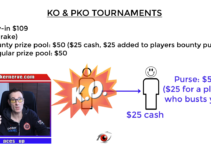ICM is a widely used mathematical model that is used to determine your equity in a tournament based on your current chip amount and the payout structure of that tournament. This typically results in more aggressive play near the money and final table bubble in order to maximize pressure on our opponents. This is something many poker plays would likely have seen before - if you haven't, check out our video on this topic.
Unfortunately, this same ICM based strategy that has proven so successful in regular tournaments could be a winning player's downfall when they play PKO tournaments.
The reason for this is that PKO tournament ICM scenarios must take into account the second (bounty) prize pool. The effect of the bounty prize pool means that typically the ICM effect is not as substantial, resulting in you no longer being able to apply as much pressure as would typically deliver an expected value (EV).

In this article let’s uncover why, along with the right adjustments to make, allowing readers to win more from PKO tournaments. To help us understand the correct shift in strategy, let's breakdown the 4 biggest blunders player pools are making in PKO ICM spots:
♠ Short stacks playing too tight ITM (in the money) bubble
♠ Short stacks jamming too wide at final tables
♠ Big stacks pressuring too wide
♠ Players calling too wide for bounties
Now let’s go through these key spots and more, including adjusting to opponents stuck playing a regular MTT strategy, so we can maximize our PKO performance!
Short stacks playing too tight ITM bubble
When you're close to the money with a short stack, should you look to survive or go for the marginal jam spot in a PKO tournament? Let's consider two interesting points before we answer this.
Firstly, we said in a previous article called Progressive Knockout Tournament Strategy - Your 2020 PKO Guide, that short stacks should play tighter in PKO tournaments because they don't have as much fold equity when moving all-in first in the pot due to players 'bounty hunting' them.
Secondly, we know that in the money bubble, vulnerable stacks should play carefully to avoid busting. Their strategy should be focused on getting a piece of the prize pool.
When you combine these two points, it would be easy to assume the answer must be to play super tight near the money, wouldn't it? However, this is not the case!
The regular prize pool is essentially half of what it would be compared to a non-PKO tournament, due to 50% of the buy-in going into the bounty prize pool. And the bounty prize pool isn't influenced by the bubble. So ICM is reduced in a progressive knockout tournament and short stacks can, therefore, jam more liberally.
Here's a video snippet from Pokernerve's Bounty Hunter Course where we analyze this important point.
[embedyt] https://www.youtube.com/watch?v=HksrmbPI3i4[/embedyt]
Short stacks jamming too wide at final tables
Having established that short stacks can be a little looser in a money bubble, it would be easy to assume the same could be said for final table play when it comes to the pay jumps, wouldn't it? Somewhat counter-intuitive, this is not the case at all.
When it comes to large pay jumps, particularly with half a dozen or so players remaining, short stacks have to play even tighter than in a regular format MTT. Remember we said in a PKO tournament short stacks have the dilemma that covering stacks will call them wide to pick-off their bounty? This concept of 'bounty hunting' is also covered in this popular article we posted.
At final tables, bounty values are usually very large. So we can assume when facing a short stack jam, covering stacks will be very incentivized to contest the pot for the bounty.
This really hurts short stacks because they'll have a much greater risk of busting when the pay jumps are most significant. The response should be for the short stacks to use a very tight strategy when moving all-in. Here's a quick tutorial on this key concept.
[embedyt] https://www.youtube.com/watch?v=KGSP4ZBvchU[/embedyt]
Covering stacks calling wider for the KO bonus results in shorter stacks being at risk more often. Especially when there are other short stacks around, and or, big pay jumps approaching. Survival is a priority. Shorter stacks anticipating their opponents calling wider, need to tighten up and adjust their range.
If you suspect your opponent is jamming a regular MTT range, including a lot of suited connectors and more marginal hands, you can really attack. Calling or isolating aggressively to take advantage of their mistake.
Big stacks pressuring too wide
A staple of good ICM play has always been those with big stacks getting to bully shorter stacks. Often collecting a ton of chips in the process. This great regular MTT strategy is a poor one in PKO tournaments. At least that is, if short stacks are playing the correct strategy! Learn all about this in the following video.
[embedyt] https://www.youtube.com/watch?v=CagMRTjtVc8[/embedyt]
Remember the prize pool is split between a regular prize pool and a bounty prize pool. The presence of this second prize pool essentially reduces the significance of the regular prize pool. Those classic ‘any two’ all-in spots to assert pressure on a shorter stack become a disaster for players still using that level of aggression.
Savvy shorter stacks can call wider than a regular MTT despite their stack being put at risk, to take advantage of the generous equity advantage they’ll have against a wide range. Whilst it’s true the risk will result in the shorter stack busting more frequently, the upside outweighs this.
Doubling-up will often result in the shorter stack being back in contention for the higher payouts. Consolidating their equity in the regular prize pool whilst also improving their chance of picking up more of the bounty prize pool. The later of which increases tremendously when they have enough chips to cover opponents. This is not too mention tournament winners receive a huge bonus amount from the bounties they’ve collected in their bounty purse along the way.
Surprise players using an overly aggressive strategy by calling more. It will be super profitable and result in a lot more PKO success in the long-run.
Players calling too wide for bounties
At the end of a tournament, bounties might be many times the buy-in you paid to play. The important thing to keep in mind is the bounty factor! That is, the relationship between the number of start bounties and the number of start stacks.
The big bounty amounts often tend to woo players into a loose call. Think methodically about the bounty factor, as you would in any PKO spot. If you aren’t sure how to use bounty factor and equity drop, two very quick in-game calculations to determine the right play in a PKO MTT, check out PokerNerve’s Bounty Hunter Course to drastically improve your PKO skill advantage.
Key endgame spots, like the one in the following video from the course, are critical to be getting right consistently.
Players tend to get fixated on the instant cash amount they can win and lose sight of other important aspects. Risking a huge portion of your stack for a bounty reward can not only leave you likely to be one of the next to bust, but also reduce your chance of picking up more bounties in the tournament. The latter of which requires you to have a covering stack.
A critical part of the game is maneuvering with a covering stack. Be sure to check out this previous article if you haven't already, Covering Stack Play in PKO Tournaments.
Ready for PKO ICM?
ICM was never an instant calculation using a formula at the table. Excellent players spent time reviewing spots to fine-tune their play. PKO ICM is no different.
A great way to improve your play is to review spots. Here's some more hand analysis by Acesup to help you focus on what is likely the most crucial ICM spot you'll encounter at final tables; The big stack moving all-in to apply pressure on the stacks behind.
Often players won't be using the right ranges in a PKO tournament when they use a big stack to apply pressure. Or if you have the bigger stack, keep in mind shorter stacks facing pressure also won't usually be playing the right ranges.
Now you know the correct strategy. Use it where applicable or modify your ranges when necessary. Adjusting to opponents who may be deviating from the optimal PKO strategy. Which is most of the time!
Summary
ICM is still a factor, but far less significant in PKO tournaments. The presence of a second prize pool, the bounty prize pool, greatly reduces ICM pressure. Resulting in some notable adjustments we need to make to be playing a profitable strategy.
Short stack jammers can’t assert as much pressure. ICM is reduced and they have a bounty on their head for knocking them out. This allows opponents the opportunity to call liberally for the reward. Resulting in a lot more risk from jamming, making tight play best.
 Big stacks also need to shift their strategy significantly. The common play of raising or jamming really wide to apply pressure to shorter stacks at a final table could be a costly error.
Big stacks also need to shift their strategy significantly. The common play of raising or jamming really wide to apply pressure to shorter stacks at a final table could be a costly error.
With a smaller regular prize pool than a normal MTT and plenty of large bounties typically left to play for, shorter stacks can take advantage of the terrific equity they’ll have in these confrontations and call really wide. Taking a chance to pick up some chips and getting them in a position to play for more bounties. This is not to mention back in contention for more of the regular prize pool, too.
Lastly, don’t get carried away calling for large bounties. Rather than thinking about the dollar amount, consider the risk versus reward. Picking up an amount equivalent to the next pay jump might be nice, but being left as a short vulnerable stack, plus covering less of the remaining players, can be extremely costly.
Preserve a healthy covering stack which can lead to future knockout opportunities and a great shot at picking-up a large chunk of the regular prize pool, too. Or better yet winning the tournament and keeping your bounty purse!
Final Word
We’ve seen the correct ranges to use can differ dramatically from that of a regular MTT. With so much on the line at the late stage of a tournament, it’s critical to hone your PKO ICM skill. For more on the adjustments to make so you can be playing as profitable as possible in PKO ICM spots, check out PokerNerve’s Bounty Hunter course. Become the best PKO player at your table and get 25% off the course with coupon code PN25.




